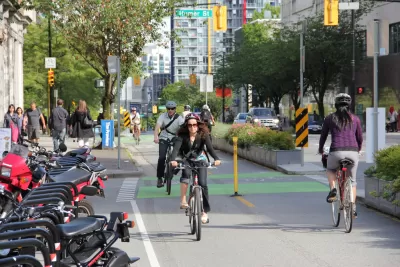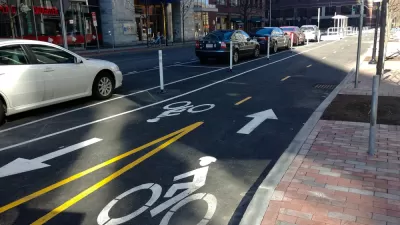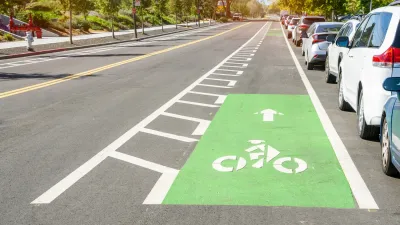The Federal Highway Administration (FHWA) on May 18 announced new guidelines for the planning and design of separated bike lanes.

Greg Nadeau, acting administrator of the FHWA, writes a post announcing the release of the Separated Bike Lane Planning and Design Guide, which, among other things, explains the importance of separated bike lanes to a multi-modal transportation system: These lanes are an important tool communities across the U.S. can use to build safe, comfortable, and connected networks of bicycle infrastructure that meet the needs of people of all ages and abilities."
In addition to a number of case studies, "FHWA’s guide outlines planning considerations and design options for this innovative bicycle facility. It provides information on one and two-way facilities, outlines different options for providing separation, and highlights midblock design considerations including driveways, transit stops, accessibility, and loading zones. Intersection design is also taken into consideration, including the related operations, signalization, signage, and on-road marking concerns."
Nadeau mentions that the new Guide is intended to support the U.S. DOT's Safer People, Safer Streets initiative.
FULL STORY: FHWA introduces Separated Bike Lane Planning and Design Guide

Trump Administration Could Effectively End Housing Voucher Program
Federal officials are eyeing major cuts to the Section 8 program that helps millions of low-income households pay rent.

Planetizen Federal Action Tracker
A weekly monitor of how Trump’s orders and actions are impacting planners and planning in America.

Ken Jennings Launches Transit Web Series
The Jeopardy champ wants you to ride public transit.

Crime Continues to Drop on Philly, San Francisco Transit Systems
SEPTA and BART both saw significant declines in violent crime in the first quarter of 2025.

How South LA Green Spaces Power Community Health and Hope
Green spaces like South L.A. Wetlands Park are helping South Los Angeles residents promote healthy lifestyles, build community, and advocate for improvements that reflect local needs in historically underserved neighborhoods.

Sacramento Plans ‘Quick-Build’ Road Safety Projects
The city wants to accelerate small-scale safety improvements that use low-cost equipment to make an impact at dangerous intersections.
Urban Design for Planners 1: Software Tools
This six-course series explores essential urban design concepts using open source software and equips planners with the tools they need to participate fully in the urban design process.
Planning for Universal Design
Learn the tools for implementing Universal Design in planning regulations.
Heyer Gruel & Associates PA
Ada County Highway District
Institute for Housing and Urban Development Studies (IHS)
City of Grandview
Harvard GSD Executive Education
Toledo-Lucas County Plan Commissions
Salt Lake City
NYU Wagner Graduate School of Public Service





























